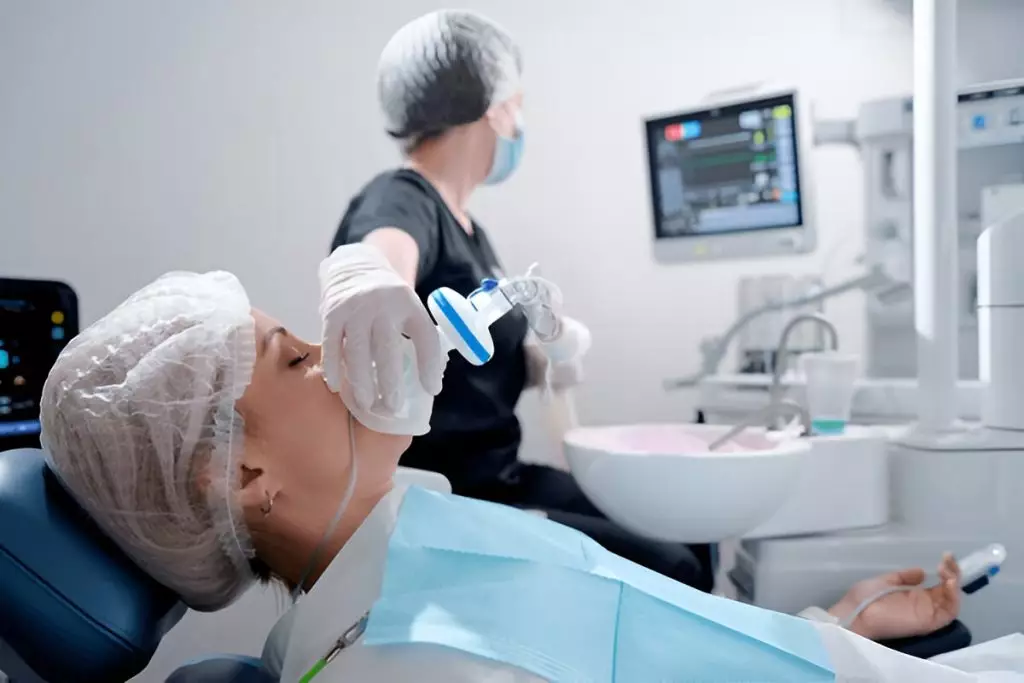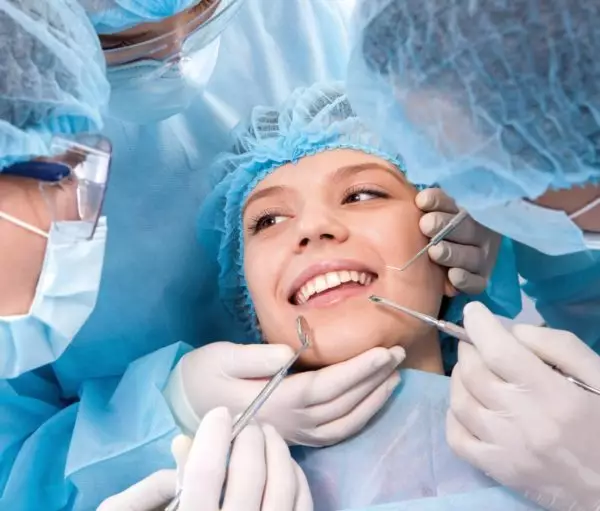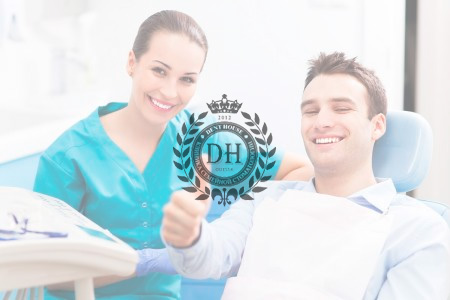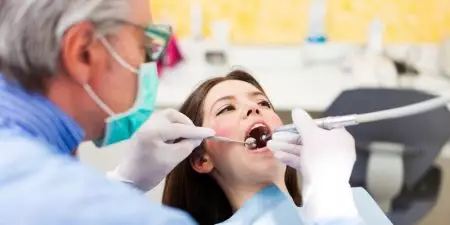- Dental treatment under general anaesthesia for children and adults
- Treatment under general anaesthesia: what it is, reasons, preparation
- How is dental treatment with general anaesthesia?
- Who should not have dental treatment under anaesthesia
- Advantages of cooperation with Dent-House Family Dentistry Clinic
- How much does dental treatment under anaesthesia cost in Odesa?
- Frequently asked questions about dental treatment under anesthesia in Odessa
- Specialists
- Make an appointment
ANAESTHESIA AND TESTS
Anaesthesia
Modern drugs used by anaesthetists for dental treatment under general anaesthesia are not addictive. do not affect memory. Medications used today for general anaesthesia do not significantly affect mental functions. As a rule, it takes no more than half an hour for the patient to regain full consciousness. The components of the drugs used for general anaesthesia are quickly eliminated from the body, leaving no trace. General anaesthesia has many advantages, but one of the main advantages is the fact that the patient does not experience a significant increase in stress hormone levels during surgery. The production of stress hormones is unavoidable in patients who choose local anaesthesia for surgery and are therefore conscious during the operation.

- presence of neurological and psychiatric diseases in the patient
- Allergy to or complete intolerance of local anaesthetic drugs
- increased gag reflex
- uncontrollable panic attacks
- major interventions (sinus lift or bone grafting, maxillofacial trauma surgery)
- individual intolerance to drugs
- pneumonia
- pathologies of the cardiovascular system
- acute or chronic diseases of the upper respiratory tract (especially dangerous in this regard are catarrh and difficulty in nasal breathing)
- liver and kidney diseases in the acute stage
- last trimester of pregnancy
Preliminarily
– test results
– 2 days before the procedure it is necessary to consult an anaesthesiologist, who must be informed of any chronic diseases, illnesses, allergic reactions, intolerance to certain drugs.
– refrain from eating 6 hours and drinking water 4 hours before your doctor’s appointment.
– Do not drive immediately after the procedure. It is advisable to have an accompanying person.
Equipment
| 1. Anaesthetic breathing apparatus – used for anaesthesia in children and adults. |
- Storm computer with gas analysis module – included with the anaesthesia and respiratory machine.
- An infusion machine is a device that, in combination with the Instilar syringe infusion pump, allows very precise control of the rate of administration of drug solutions.
- AirSep oxygen concentrator (USA) is used for oxygen production. AirSep is connected to the anaesthesia and respiratory machine and provides a constant supply of oxygen during surgery under anaesthesia.
- Storm 5000 portable pulse oximeter is a control and diagnostic device designed to measure arterial capillary blood haemoglobin saturation with oxygen and pulse rate.
- Portable electrochemical glucometer is a control and diagnostic device designed to measure blood sugar levels.
Dental treatment under general anaesthesia for children and adults
Dental treatment under anaesthesia is a manipulation that is performed while the patient is in a state of sleep with temporary disabling of consciousness, pain sensitivity and reflexes. Do not confuse anaesthesia and medication sleep: medication sedation – intravenous or inhalation administration of sedative drugs, which does not disable consciousness and only dulls reflexes, plunging the patient into a state of light surface sleep. Under anaesthesia, you do not feel pain, do not see the doctor’s manipulations and wake up after the treatment is completed.
Treatment under general anaesthesia: what it is, reasons, preparation
Dentistry is a field of medicine that is constantly evolving. A decade ago, it was hard to imagine that dental treatment could take place quickly, without fear or pain. Unfortunately, many people still suffer from dentophobia – the fear of dentists. For them, as well as for other patients, modern clinics offer treatment under general anaesthesia rather than local anaesthesia. This procedure is absolutely safe and allows you to perform any, even the most complex manipulations.
General anaesthesia is a well-known method used during surgical interventions. An anaesthesiologist injects a special drug into the body, thanks to which a person falls into a state of deep sleep and does not feel pain. Meanwhile, the doctor can carry out any manipulations. Modern drugs are not addictive, absolutely safe and allow you to quickly recover from the procedure. The price of the procedure depends on the duration of anaesthesia.
General anaesthesia is given to both children and adults. There are many different reasons for this:
- fear of dentists;
- allergy to local anaesthetic drugs;
- mental and neurological illnesses;
- increased gag reflex;
- panic attacks;
- low pain threshold;
- an extensive frontline for the dentist.
The patient is prepared in advance for dental treatment under general anaesthesia. It is obligatory to take tests and consult with the anaesthesiologist. You should definitely tell the doctor about chronic diseases, allergies and other health problems.

How is dental treatment with general anaesthesia?
Treatment under anaesthesia is unnoticeable. Alternatively, a special breathing mask is placed on the patient’s face, he closes his eyes, falls asleep almost instantly and wakes up only when all the procedures have been completed. Also in some cases, anaesthesia is administered intravenously.
Note that on the day of dental treatment under anaesthesia, you should not eat food 6 hours before the procedure and drink water 4 hours before. You should not drink alcohol the day before.
During treatment, an anaesthesiologist and his assistant are constantly with the patient. Specialists monitor your well-being and condition – breathing, pulse, heart rate, blood pressure, body temperature. The respiratory tract is also protected from foreign particles.
At the Dent-House Family Dentistry Clinic, doctors use the latest equipment – an anaesthetic breathing machine, a computer with a gas analysis module, an oxygen concentrator and a portable pulse oximeter. This allows to ensure maximum safety and efficiency of treatment for the patient.
After coming out of anaesthesia, there may be a slight dizziness, weakness, which disappears after 15-20 minutes. We recommend that patients stay in the clinic for 1-2 hours. After that, you can go home. Drinking water is allowed after an hour, and liquid food after 2 hours. However, please note that driving is prohibited. It is also necessary to refuse alcohol.
General anaesthesia is well tolerated by both adults and children. After the procedure, young patients are sometimes cranky, but this quickly subsides. Side effects in the form of nausea and vomiting are extremely rare.
Usually general anaesthesia allows the doctor to perform procedures for 1-5 hours. It is possible to do quite a lot of work during this time.
Who should not have dental treatment under anaesthesia
Unfortunately, dental treatment under anaesthesia is not suitable for everyone. It is categorically not recommended for people who have:
- individual intolerance to the drugs used for anaesthesia;
- heart disease, kidney disease, liver disease;
- endocrine problems;
- anaemia;
- malignant diseases;
- epilepsy.
Postponing treatment is also necessary for people who have:
- bronchial asthma in the period of exacerbation;
- had a recent heart attack or stroke (you must wait at least six months);
- acute upper respiratory tract diseases (wait 2 weeks after full recovery);
- pneumonia;
- was a recent vaccination.
Unfortunately, dental treatment under anaesthesia is not suitable for everyone.

Advantages of cooperation with Dent-House Family Dentistry Clinic
“Dent-House” is a clinic of family dentistry in Odessa with many years of experience. Advantages of co-operation with us:
- A wide range of services. In our dental clinic you can treat tooth decay, teeth whitening and implantation, braces, veneers and orthopaedic constructions of any level of complexity, bruxism treatment.
- Family-centred approach. At our clinic, we will plan and treat all members of your family at the same time, making the most of your time at Dent-Haus.
- Personalised approach. Each case is special. That is why we prepare a personalised treatment plan for each patient in Odessa.
- Professional equipment. We use only innovative technologies to carry out even the most complex treatments.
- High-quality specialists.All our doctors are professionals with extensive experience. In addition, doctors are constantly upgrading their qualifications, which is confirmed by numerous certificates and diplomas. All doctors necessarily use an interdisciplinary approach and work in a team, which improves the quality of services and reduces treatment time.
- Sterility. The safety of our clients is paramount. That is why we use the latest equipment for sterilising instruments and regularly disinfect the clinic.
- Pricing Policy. With a wide selection of materials, we offer patients treatment plans in several pricing options.
- Interior. The clinic of family dentistry “Dent-House” in Odessa is a separate building with a cosy and modern interior. Each dental cabinet is decorated thematically. There is also a foyer, a patio with natural greenery, and a recreation area at your disposal.
Our dentistry will appeal to people who value quality, comfort, safety and their time.
How much does dental treatment under anaesthesia cost in Odesa?
The exact cost of dental treatment under general anaesthesia will be individualised in each case. The price of sleep treatment at the Dent-House Clinic depends on the duration of the procedure and the drugs used.
You can find out the cost of treatment from the receptionist. Call the phone numbers listed in the “contacts” section and make an appointment for a consultation or appointment at a convenient time. Also on our website you can find out prices, read reviews and familiarise yourself with the protocols of various procedures.
Course of the procedure

The patient closes their eyes before treatment begins and opens them after treatment is completed.

During the entire procedure, an anaesthetist works alongside the dentist to closely supervise:
- patient well-being
- depth of sedation
- ECG in three leads to monitor heart function
- pulse oximetry to determine blood oxygen saturation
- blood pressure and body temperature
Frequently asked questions about dental treatment under anesthesia in Odessa
🦷 What are the side effects of anesthesia at the dentist?
😁 Can there be an allergic reaction to anesthetics?
🦷 What should you absolutely not do before anesthesia?
😁 What questions does the anesthesiologist ask before anesthesia?
Cost of services
-
General anaesthesia (with mechanical ventilation for up to 3 hours) in 60 minutes 5,000 UAH
Specialists

Ekaterina Sergeevna Furduy
Paediatric dentist





